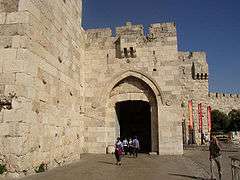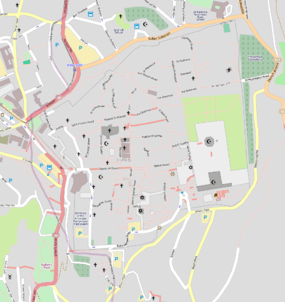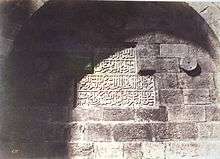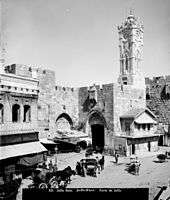Jaffa Gate
| Jaffa Gate | |
|---|---|
 Jaffa Gate | |
 Location in Old Jerusalem | |
| General information | |
| Town or city | Old City (Jerusalem) |
| Coordinates | 31°46′35.5″N 35°13′39.7″E / 31.776528°N 35.227694°E |
Jaffa Gate (Hebrew: שער יפו, Sha'ar Yafo; Arabic: باب الخليل, Bab al-Khalil, "Hebron Gate"; also Arabic, Bab Mihrab Dawud, "Gate of the Prayer Niche of David"; also David's Gate) is a stone portal in the historic walls of the Old City of Jerusalem. It is one of eight gates in Jerusalem's Old City walls.
Jaffa Gate is the only one of the Old City gates positioned at a right angle to the wall. This could have been done as a defensive measure to slow down oncoming attackers,[1] or to orient it in the direction of Jaffa Road, from which pilgrims arrived at the end of their journey from the port of Jaffa.
Names
Both the Jaffa Gate and Jaffa Road are named after the port of Jaffa, from which the Prophet Jonah embarked on his sea journey[2] and pilgrims debarked on their trip to the Holy City. The modern-day Highway 1, which starts from the western end of Jaffa Road, completes the same route to Tel Aviv-Jaffa.
The Arabic name for the gate, Bab el-Khalil (Gate of the Friend), refers to Abraham, the beloved of God who is buried in Hebron. Since Abraham lived in Hebron, another name for the Jaffa Gate is "Hebron Gate". The Arabs also called this gate Bab Mihrab Daud (Gate of the Prayer Niche of David), since King David is considered a prophet by Islam. The Crusaders, who rebuilt the citadel to the south of Jaffa Gate, also built a gate behind the present location of Jaffa Gate, calling it "David's Gate".
Architecture
Like the stones used for the rest of the Old City walls, the stones of Jaffa Gate are large, hewn, sand-colored blocks.[3] The entryway stands about 20 feet (6 meters) high, and the wall rises another 20 feet above that.[4]


Immediately next to the old gate, which is used only by pedestrians, is a breach in the wall, through which the roadway passes. According to legend, this was made in 1898 when German Emperor Wilhelm II insisted on entering the city mounted on his white horse. Local legend said that Jerusalem would be ruled by a king who entered the city's gates on a white horse, so to satisfy the emperor's vanity and avoid the fate foretold by legend, a breach was made in the wall rather than allow him to ride through a gate. However, photographs from 1880 show that the city wall was never continuous at that point owing to a moat around the Citadel / Tower of David that interrupted the wall's path. The moat has since been filled in, leaving the gap today.[5]
Tower of David / the Citadel
The Tower of David is an ancient citadel located near the Jaffa Gate entrance to the Old City of Jerusalem. Built to strengthen a strategically weak point in the Old City's defenses, the citadel that stands today was constructed during the 2nd century BCE and subsequently destroyed and rebuilt by, in succession, the Christian, Muslim, Mamluk, and Ottoman conquerors of Jerusalem. The strong bulwarks still seen today surrounding the base of the tower are believed to have been built by king Herod, in memorial of his brother, and was formerly named the Tower of Phasael (Hebrew: מגדל פצאל).[6][7] It contains important archaeological finds dating back 2,700 years, and is a popular venue for benefit events, craft shows, concerts, and sound-and-light performances.
Kilometre Zero of Israel
After the recapture of Jerusalem in CE 132 the emperor Hadrian had the city rebuilt as a Roman city called Aelia Capitolina and a tall pillar in the plaza inside the Damascus Gate was the starting point for measurements to other cities, as indicated in the mosaic Madaba Map. This pillar appears to have fallen or been demolished during the Byzantine period.
In the 20th Century the plaza outside the Jaffa Gate served the same purpose. During the British Mandate for Palestine a marker outside the doorway served as the zero point for distances to and from Jerusalem. There is no such marker today.
Bezalel Pavilion

Bezalel Pavilion near Jaffa Gate was a tin-plated wooden structure with a jagged roof and tower, built in 1912 at a shop and showroom in Bezalel Academy of Arts and Design. It was designed specifically for tourists and passersby on their way to and exiting the Old City. The pavilion was destroyed six years after it was established.
Clock Tower

In 1907 a clock was built on the roof of the Jaffa Gate and in 1908 a clock tower was built over the gate to serve the developing business district in the upper part of the Hinnom Valley. It was meant to be one of approximately one hundred such clock towers built throughout the Ottoman Empire in 1900 in celebration of the 25th year of rule of Sultan Abdul Hamid II. The tower cost 20,000 francs; such was the poverty of the city that the money was not raised – and therefore the clock tower was not completed – until 1908.[8]
Seven such clock towers were erected in what is now Israel and the Palestinian Territories – in Safed, Acre, Haifa, Nazareth, Nablus, Jerusalem, and the famous tower in Jaffa. The fact that the Jaffa Gate in Jerusalem was selected for the clock tower indicates the gate's importance at the time, even more than the Damascus Gate.
The clock tower was built of limestone quarried from the nearby Zedekiah's Cave. It stood 13 feet tall, and was topped by four clock faces, oriented to the cardinal compass points. The eastern and western faces showed official time (European time) while the northern and southern faces showed local time. Above the clock faces was a bell and the crescent and star symbol of Ottoman rule.
The Turkish clock tower only lasted for a decade and was knocked down by the British in 1922 – for aesthetical reasons.[8] The clock itself was re-erected on a modern, far less decorated tower at Allenby Square near the British Post Office and City Hall; this British-built tower was itself ultimately demolished in 1934.[9][10]
Turkish-Ottoman Sebil

At the entrance to Jaffa Gate, near the Bezalel Pavilion, was a sebil built by the Sultan.
History
Jaffa Gate was inaugurated in 1538 as part of the rebuilding of the Old City walls by Suleiman the Magnificent.[3]

Just inside the gate, behind an iron grating on the left, lie two tombs. These are believed to be the graves of the two architects whom Suleiman commissioned to construct the Old City walls. According to legend, when Suleiman saw that the architects had left Mount Zion and the tomb of King David out of the enclosure, he ordered them killed. However, in deference to their impressive achievement, he had them buried inside the walls next to Jaffa Gate.[11]
In 1917, British general Edmund Allenby entered the Old City through the Jaffa Gate,[12] giving a speech at the nearby Tower of David. Allenby entered the city on foot in a show of respect for the city and a desire to avoid comparison with the Kaiser's entry in 1898. The British demolished other buildings adjoining the city wall in 1944 in an attempt to preserve Jerusalem's historic vistas.
During the 1948 Arab–Israeli War, Israeli forces fought hard to connect the Jewish Quarter of the Old City with Israeli-held western Jerusalem by controlling the Jaffa Gate. Israeli forces were not able to gain control of the gate until the Six Day War in 1967.
In 2000, Pope John Paul II came through Jaffa Gate to the Old City during his visit in Israel in the Holy Year.
The street leading east from the Jaffa Gate was once called "Capital Street" but today is known as "David Street" and is one of the principal streets for souvenir shopping.
Topography

Inside Jaffa Gate is a small square with entrances to the Christian Quarter (on the left), Muslim Quarter (straight ahead) and the Armenian Quarter (to the right, past the Tower of David). A tourist information office and shops line the square. The entrance to the Muslim Quarter is part of the suq (marketplace).
The gate's location is determined by the city's topography, located along the valley followed by Jaffa Road into the old city, between the northern hill of the Acra and the southern hill of Mount Zion.[13] The road and the valley it follows continue eastward and down into the Tyropoeon Valley, bisecting the northern and southern halves of the city, with the Christian and Muslim Quarters to the north, and Armenian and Jewish Quarters to the south.
South of the Jaffa Gate is the Tower of David, one of Jerusalem's distinctive landmarks. It is believed to be built on the site of Herod the Great's tower Phasael, but the present fortress was built during the reign of Suleiman the Magnificent. It is called the Tower of David because of an association with a tower described in the Hebrew Bible.
Renovation

Jaffa Gate is heavily used by pedestrians and vehicles alike. In the early 2000s (decade), the road straddling the gate was moved further west and a plaza constructed in its stead to connect Jaffa Gate with the soon-to-be-built Mamilla shopping mall across the street.
In 2010, the Israel Antiquities Authority completed a two-month restoration and cleaning of Jaffa Gate as part of a $4 million project begun in 2007 to renovate the length of the Old City walls.[4] The clean-up included replacing broken stones, cleaning the walls of decades of car exhaust, and reattaching an elaborate Arabic inscription erected at the gate's original dedication in 1593. Bullet fragments in the gate, from fighting in the 1948 Arab–Israeli war, were preserved.[14] Infrastructure work beside Jaffa Gate also uncovered an ancient aqueduct dating from the 2nd or 3rd century CE.[15]
References
- ↑ "Jerusalem – The Old City". Jewish Virtual Library. Retrieved 2010-05-03.
- ↑ Jonah 1:3.
- 1 2 "Jerusalem reopens Jaffa Gate after two-month renovation". Haaretz. 2010-04-21. Retrieved 2010-05-03.
- ↑ http://blogs.timesofisrael.com/jerusalem-mystery-solved/
- ↑ Geva, Hillel (1981). "The 'Tower of David'—Phasael or Hippicus?". Israel Exploration Journal. 31 (1/2): 57–65. JSTOR 27925783. (registration required (help)). While biblical scholar Robinson and archaeologist Geva proposed that the tower known as Hippicus be identified with the "Tower of David," this proposal was not accepted by archaeologists J. Fergusson, Thomas Lewin, Schick, G.A. Smith, C. Warren and C.R. Conder, who held that the tower of Phasael should be identified with the "Tower of David," based on its size.
- ↑ Jerome Murphy-O'Connor, The Holy Land: An Oxford Archaeological Guide from Earliest Times to 1700, Oxford University Press (5th edition), New York 2008, pp. 23–25 ISBN 978-0-19-923666-4; with an illustration showing the contour of the Phasael Tower walls, and walls built in later centuries.
- 1 2 Goldhill, Simon (2009). Jerusalem: City of Longing. Harvard University Press. pp. 146–147. ISBN 978-0674037724.
- ↑ Todd Bolen, The Whereabouts of the Jaffa Gate Clock Tower, 17 April 2010
- ↑ The Palestine Post, 27 September 1934, p. 6 (via National Library of Israel, Tel Aviv University: JPress - collection of historical Jewish press)
- ↑ "Lions in Jerusalem". Jerusalem Municipality. Retrieved 2010-05-03.
- ↑ "Edmund Allenby Entering Jaffa Gate, Jerusalem – Signed Photograph". Shapell Manuscript Collection. SMF.
- ↑ James Kean, "Among the holy places" (book excerpt)
- ↑ "Jerusalem's Jaffa Gate is reopened". Jewish Telegraphic Agency. 2010-04-21. Retrieved 2010-05-03.
- ↑ "The 1,800 Year Old High-Level Aqueduct of Jerusalem was Exposed Next to Jaffa Gate in the Old City". Israel Antiquities Authority Press Office. 2010-02-19. Retrieved 2010-05-03.
External links
| Wikimedia Commons has media related to Jaffa Gate. |
- Mashiah A., Avraham Y., Kacho E., Avrahami M., Yogev A. (2008). Conserving the Engineers’ Tombs in the Jaffa Gate Plaza, Conservation Department – Israel Antiquities Authority.
Virtual tours
Coordinates: 31°46′35.5″N 35°13′39.7″E / 31.776528°N 35.227694°E